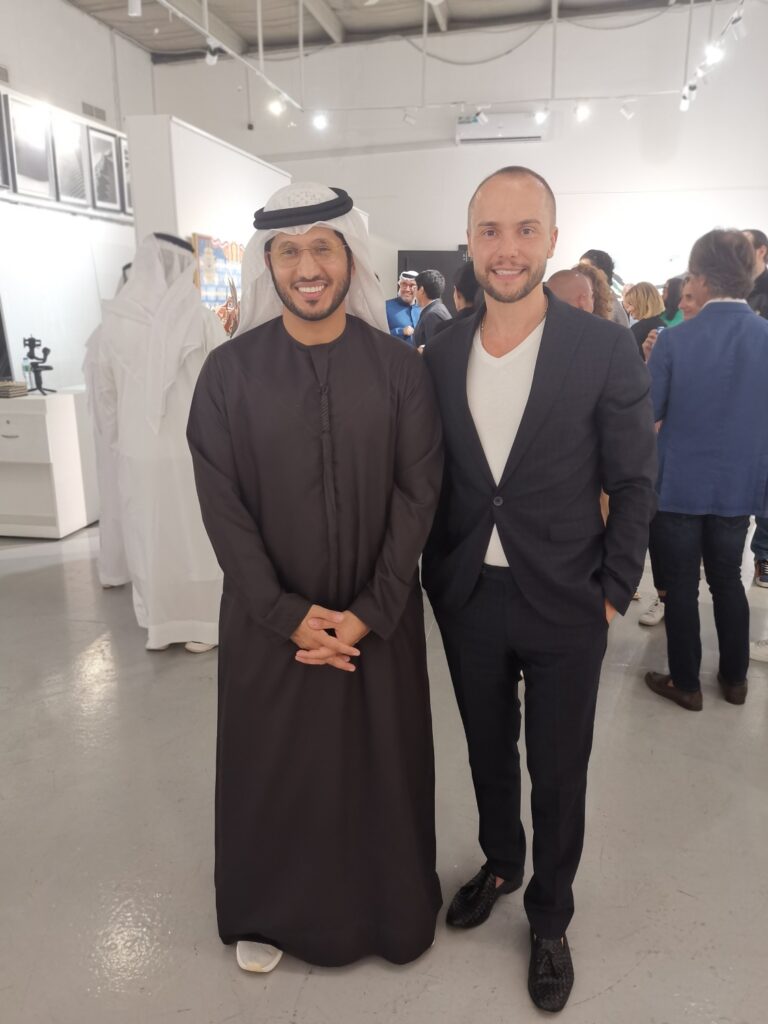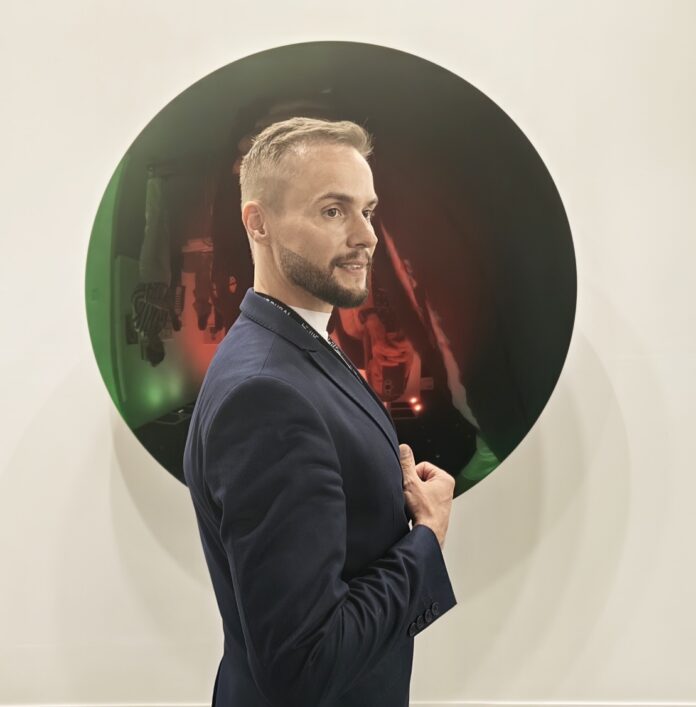Cultural analyst, editor and journalist Egor Sharay, who has been living and working in Dubai since 2008, provides valuable insights into the development of culture and art in the UAE. In his interview, he elaborates on the country’s embrace of the creative economy and its more liberal immigration policies for creative professionals.
Throughout his time in the UAE, Sharay has had the unique opportunity to engage with prominent cultural and artistic figures. Their expert opinions and perspectives have significantly influenced his understanding of socio-cultural events in the region, establishing him as a leading expert in the creative industries in the Middle East.
Reflecting on the evolution of Dubai’s cultural landscape, Egor Sharay noted: “The increasing demand for a new artistic environment has become a central focus in the country’s strategic development plans. This has led to the establishment of museums, cultural foundations, and art centers. Recent high-profile global projects include the Louvre Abu Dhabi, the Guggenheim Museum in Abu Dhabi, and the Art Jameel Center.”
Sharay further elaborated on the significance of regional art events: “For the past 30 years, the Sharjah Biennial has been a prominent fixture in Sharjah, establishing itself as one of the most prestigious contemporary art exhibitions in the Middle East. Organized by the Sharjah Art Foundation under the leadership of Sheikha Hoor Al Qasimi, daughter of the ruler, the biennial has gained significant acclaim. Additionally, Art Dubai, the largest art fair in the region, has been held for 17 years with the support of Dubai’s ruler, Sheikh Mohammed bin Rashid Al Maktoum.”
Discussing the influences on contemporary Middle Eastern art, Sharay observed: “Artists from the Middle East, North Africa, and the Arab world draw inspiration from a diverse range of sources. While some focus on traditional crafts and Islamic art, others are influenced by Coptic art or find ideas in Western art. This interplay of various traditions results in a rich and eclectic body of work, characterized by its multifaceted nature.”

Regarding the finest examples of regional art, Egor highlighted the Barjeel Art Foundation’s collection: “The Barjeel Art Foundation’s collection of works by Middle Eastern artists is particularly noteworthy. It provides a comprehensive view of how abstract art has evolved in the Arab world, reflecting a rich tapestry of influences that include not only Western art but also the Casablanca, Khartoum, and Baghdad Schools.”
Egor Sharay also shared the origin story of the Barjeel Art Foundation: “Its founder, Sultan Sooud Al Qassemi, spent several years, from 2002 to 2008, amassing a significant collection of contemporary Arab art. The growing public interest in his collection led him to the idea of establishing a formal institution, though he initially lacked a suitable venue. In 2008, he sought assistance from the Sharjah government, and a year later, in 2009, he was granted space in a beautifully restored building in the Al Qasba district of Sharjah. This area was envisioned by the emirate’s leadership as a future creative hub.”
On the topic of the creative economy, Sharay explained: “In essence, the creative economy represents the synergy between corporations, businesses, and the arts. The global shift is moving away from a resource-based economy towards one centered on creative products. Intellectual property has become the most valuable asset. For instance, the valuation of Zoom—familiar to many during the pandemic lockdowns—exceeds the combined worth of the world’s leading airlines. Currently, in Europe, creative industries account for approximately 7% of GDP, while in Russia it is around 3%, and in Dubai about 5%.”
Egor Sharay also addressed his specialization in creative clusters: “Certainly. In recent years, my media and journalistic work has increasingly centered on creative industries and culture, which are pivotal in shaping the modern economic landscape. The creative economy is a particularly fascinating area of study. It is crucial to communicate its trends and principles to a wide audience, fostering engagement and support for these initiatives.”
He praised Austria’s early recognition of creative industries: “Austria was a pioneer in recognizing the significance of creative industries within the framework of innovation policy, incorporating them into its national strategy for research, technology, and innovation as early as 2011. In Austria, creative industries represent over 10% of all businesses (approximately 42,000) and contribute 3.8% to GDP, a figure comparable to that of the tourism sector. These industries have been a major driver of economic growth, with revenue increasing by 21% from 2008 to 2016, compared to 8% for the overall economy, and employment rising by 16% compared to 7% for the general economy.”
Regarding the UAE government’s initiatives, Egor Sharay remarked: “There is a vibrant development of creative clusters, centers, and hubs in Dubai and the neighboring emirates. Industrial areas are being repurposed into art districts, and new cultural venues are being introduced to cater to discerning audiences, showcasing established and successful artists. The process involves presenting a compelling idea, connecting with key individuals within these centers, promoting your concept, and securing opportunities for realization. Dubai boasts dozens of these innovative clusters.”
He highlighted the transformation of the Alserkal district: “One of the most fashionable districts in contemporary Dubai, Alserkal, has developed from its origins as an industrial warehouse area. In the mid-2000s, Al Quoz was primarily occupied by warehouses and offices for industrial and logistics companies. Today, it has transformed into a vibrant arts hub, offering a comprehensive array of amenities for modern artists. The district now features over twenty galleries showcasing and selling contemporary art, a cinema that screens subtitled art-house films, coffee shops with specialty roasts, a variety of restaurants including vegan options, a retail store, and several co-working spaces.”
When asked about his plans to write a book, Sharay shared his enthusiasm: “The notion that ‘creating books is in a trend now’ deeply fascinates me. This concept encompasses a vast world of creative processes and their economic ramifications: popularity generates demand, which translates into orders for printing presses and supports numerous jobs. Additionally, the collaboration with designers and illustrators further highlights the creative aspect of the industry. This dynamic and ongoing process is precisely what I aim to explore in the book I am currently working on. I will be sure to share any updates with you as soon as I have them.”
Finally, Sharay commented on the UAE’s approach to attracting artists: “The government has actively sought to attract creative expatriates by implementing the Golden Visa policy for exceptional individuals. Due to my creative endeavors and my work as an editor and journalist in Dubai over the past 14 years, I was honoured with the Cultural Golden Visa and have been engaged in cultural projects for several years, including EXPO 2020 Dubai official programme. Previously, the relationship between individuals and the state was primarily regulated by business laws, requiring creative professionals to hold a work or investor visa if they established their own company. Now, the country’s leadership has expanded opportunities for those in creative fields, offering Golden Visas to the most distinguished talents. Consequently, artists, in a broad sense, can now reside and work in the country independently of their visa sponsors.”
